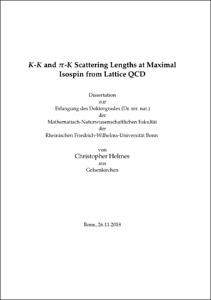Helmes, Christopher: K-K and π-K Scattering Lengths at Maximal Isospin from Lattice QCD. - Bonn, 2019. - Dissertation, Rheinische Friedrich-Wilhelms-Universität Bonn.
Online-Ausgabe in bonndoc: https://nbn-resolving.org/urn:nbn:de:hbz:5n-55294
Online-Ausgabe in bonndoc: https://nbn-resolving.org/urn:nbn:de:hbz:5n-55294
@phdthesis{handle:20.500.11811/8049,
urn: https://nbn-resolving.org/urn:nbn:de:hbz:5n-55294,
author = {{Christopher Helmes}},
title = {K-K and π-K Scattering Lengths at Maximal Isospin from Lattice QCD},
school = {Rheinische Friedrich-Wilhelms-Universität Bonn},
year = 2019,
month = aug,
note = {The current work presents calculations of the elastic scattering length a0 for systems of two Kaons and one pion and one Kaon, respectively. The values for a0 have been obtained from lattice QCD simulations with Nf = 2+1+1 dynamical flavors in the sea. The gauge configurations used in this work have been generated by the European twisted mass collaboration (ETMC) and comprise pion masses in the range 230 - 450 MeV at 3 distinct lattice spacings. The gauge configurations are realized in a maximally twisted mass setup. For the valence sector we adopt a mixed action approach with one doublet of mass degenerate light quarks and one Osterwalder-Seiler valence strange quark at different values of the strange quark mass. Within the framework of stochastic Laplacian-Heaviside (sLapH) quark field smearing we calculate the two point correlation functions of the K+ and p+, respectively and the four point correlation function of the p+-K+ and the K+-K+ system. Thermal pollution is handled via a ratio of shifted correlation functions (K+-K+) and two variants of weighting-and-shifting the correlation functions. The energies extracted from the four and two point functions are used to calculate the scattering length a0 for each system via Lüscher's method. Because of the unphysical quark masses, necessary for stable simulations, chiral inter- and extrapolations of the data are in order. We employ two procedures to fix the strange quark mass to its physical value, the Kaon mass at leading order chiral perturbation theory and its next to leading order form. For K+-K+ we resort to a combined chiral and continuum extrapolation, linear in the light quark mass, to arrive at the physical light quark mass. Thus we find
In the case of p+-K+ we extrapolate to the physical pion mass following the next to leading order for the scattering length in SU(3) ChPT. Here we find at the physical point
A further result of this study is that Chiral perturbation theory works well for the systems under considerations. For maximal isospin scattering lengths higher order terms of ChPT contribute only mildly to the leading order behavior.},
url = {https://hdl.handle.net/20.500.11811/8049}
}
urn: https://nbn-resolving.org/urn:nbn:de:hbz:5n-55294,
author = {{Christopher Helmes}},
title = {K-K and π-K Scattering Lengths at Maximal Isospin from Lattice QCD},
school = {Rheinische Friedrich-Wilhelms-Universität Bonn},
year = 2019,
month = aug,
note = {The current work presents calculations of the elastic scattering length a0 for systems of two Kaons and one pion and one Kaon, respectively. The values for a0 have been obtained from lattice QCD simulations with Nf = 2+1+1 dynamical flavors in the sea. The gauge configurations used in this work have been generated by the European twisted mass collaboration (ETMC) and comprise pion masses in the range 230 - 450 MeV at 3 distinct lattice spacings. The gauge configurations are realized in a maximally twisted mass setup. For the valence sector we adopt a mixed action approach with one doublet of mass degenerate light quarks and one Osterwalder-Seiler valence strange quark at different values of the strange quark mass. Within the framework of stochastic Laplacian-Heaviside (sLapH) quark field smearing we calculate the two point correlation functions of the K+ and p+, respectively and the four point correlation function of the p+-K+ and the K+-K+ system. Thermal pollution is handled via a ratio of shifted correlation functions (K+-K+) and two variants of weighting-and-shifting the correlation functions. The energies extracted from the four and two point functions are used to calculate the scattering length a0 for each system via Lüscher's method. Because of the unphysical quark masses, necessary for stable simulations, chiral inter- and extrapolations of the data are in order. We employ two procedures to fix the strange quark mass to its physical value, the Kaon mass at leading order chiral perturbation theory and its next to leading order form. For K+-K+ we resort to a combined chiral and continuum extrapolation, linear in the light quark mass, to arrive at the physical light quark mass. Thus we find
MKa0 = -0.385(16)stat(+0-12)ms(+0-5)ZP(4)rf,
with systematic uncertainties stemming from the quark mass fixing (ms), the renormalization procedure (ZP) and the neglect of higher order terms in the expansion of the energy shift in terms of the a0 and the inverse lattice volume. In the extrapolation the lattice artifact is found to be negligible.In the case of p+-K+ we extrapolate to the physical pion mass following the next to leading order for the scattering length in SU(3) ChPT. Here we find at the physical point
µpKa03/2 = -0.0463(17).
In this analysis we are not able to resolve possible lattice artifacts.A further result of this study is that Chiral perturbation theory works well for the systems under considerations. For maximal isospin scattering lengths higher order terms of ChPT contribute only mildly to the leading order behavior.},
url = {https://hdl.handle.net/20.500.11811/8049}
}






